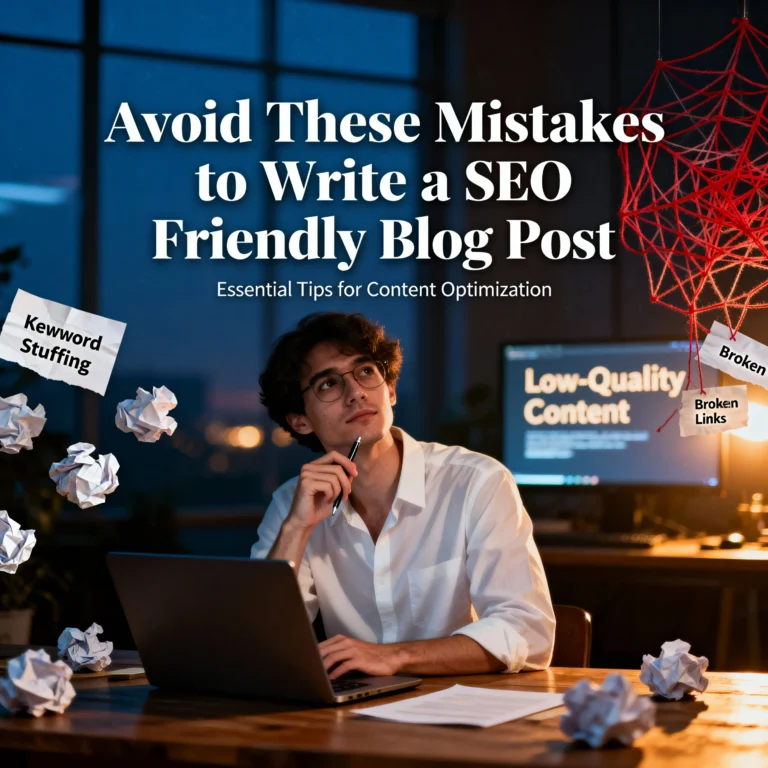How to Avoid Common Problems and Create a Truly SEO-Friendly Blog Post
Posted On November 11th, 2025
Array
Creating an SEO-friendly blog post is not just about adding keywords and writing long paragraphs. It’s about balance — making the content useful for readers and optimized for search engines at the same time. A well-written SEO-friendly blog not only attracts organic traffic but also builds credibility, improves visibility, and encourages readers to trust the website. In this detailed guide, we’ll talk about fifteen essential points to avoid when writing a SEO-friendly blog post, why they matter, and how ignoring them can harm your rankings.
From missing keyphrases to poor meta descriptions, each point plays a vital role in shaping a friendly and professional SEO blog post. The goal is to help you understand how to write a high-quality blog that ranks well, reads naturally, and connects with your audience.
1. Outbound Links and Their Impact on an SEO-Friendly Blog Post
Outbound links are external links that direct readers to other websites. While they may seem useful, overusing them can reduce your blog’s authority. In an SEO-friendly blog post, every link should add value. Too many outbound links might send visitors away too soon, which lowers engagement metrics.
To keep your SEO-friendly blog effective, use outbound links wisely. Focus on internal value before guiding readers elsewhere. When your blog post becomes a reliable resource, it naturally earns better trust and ranks higher in search results.
2. Keyphrase in Image Alt Attribute for a Better SEO-Friendly Blog
Images play a vital role in any SEO-friendly blog post. Search engines can’t “see” images, so they rely on alt attributes to understand what the image represents. By adding your SEO-friendly keyphrase in the image alt text, you help search engines understand the relevance of your content.
However, overloading the alt attribute with keywords can look unnatural. The best SEO-friendly blog practice is to describe the image naturally, keeping it short, clear, and relevant. It improves both accessibility and ranking potential.
3. The Role of Images in an SEO-Friendly Blog Post
Images make your SEO-friendly blog visually appealing. They break long paragraphs and make reading enjoyable. But many creators either skip adding images or add them without optimization. An image-heavy blog without proper compression or description can slow loading speed — a major SEO issue.
In a friendly and optimized blog post, images must be lightweight, properly titled, and relevant. Fast-loading visuals enhance the reader’s experience and signal to search engines that your page is well-optimized.
4. Using the Keyphrase in the Introduction of an SEO-Friendly Blog
The introduction is the first impression. Search engines and readers both scan the opening lines to understand what the content is about. Placing your SEO keyphrase naturally within the introduction improves visibility. It shows that your post is focused and relevant to the topic.
Avoid stuffing too many keywords at the start. In a friendly SEO blog, the introduction should flow smoothly and capture attention. Balanced keyword placement sets the tone for the rest of the article.

5. Importance of the Keyphrase in the SEO Title of a Blog Post
The SEO title is one of the strongest ranking signals for any SEO-friendly blog post. Including your main keyphrase here helps search engines quickly identify your blog’s topic. The title also influences click-through rates, which means it directly affects your traffic.
An SEO-friendly blog should have a clear, readable, and engaging title. When readers find the title helpful and relevant, they are more likely to click and stay longer.
6. Keyphrase Length and Its Role in an SEO-Friendly Blog Post
Choosing the right length for your keyphrase is crucial. Too short, and it may not target the right audience. Too long, and it may become hard to use naturally. A balanced SEO-friendly keyphrase helps create a post that reaches your exact audience without over-optimization.
Long-tail keywords, for example, help your blog appear in more specific searches, which increases traffic quality. The more precise your SEO-friendly blog is, the better your chances of ranking well.
7. Using the Keyphrase in the Meta Description of a Blog Post
A meta description is a short summary that appears below your title in search results. Including the keyphrase here improves visibility and encourages users to click your SEO-friendly blog post.
When searchers see their keywords in your meta description, they feel the content will answer their question. Make it concise, informative, and natural — never robotic. A well-optimized meta description strengthens both SEO and user trust.
8. Avoiding Previously Used Keyphrases in an SEO-Friendly Blog
Using the same keyphrase in multiple posts causes keyword cannibalization, where your own blogs compete with each other. It confuses search engines and reduces your overall ranking potential.
Each SEO-friendly blog post should target a unique focus keyphrase. By diversifying your keywords, you expand your reach, cover more topics, and enhance your site’s authority.
9. Including the Keyphrase in the Blog Post Slug
A slug is the part of your URL that appears after your domain name. A clean, readable, and SEO-friendly slug that contains your keyphrase helps search engines understand your topic easily.
For example, “/seo-friendly-blog-post” is much better than “/post12345.” Always keep slugs short and descriptive. A well-structured URL is an essential part of an SEO-friendly blog post.

10. Meta Description Length and SEO-Friendliness
While using the keyphrase is important, so is the length of your meta description. Too short, and it won’t attract clicks. Too long, and search engines will cut it off. The ideal SEO-friendly meta description is between 140–160 characters, providing clear and valuable information.
A balanced meta description not only improves SEO but also makes your blog more friendly and user-oriented.
11. The Power of Internal Links in an SEO-Friendly Blog Post
Internal links connect one post to another on the same website. They help users explore related content and help search engines understand your site’s structure. In an SEO-friendly blog, internal links distribute authority and keep readers engaged longer.
Always use relevant anchor text, and avoid overlinking. When done right, internal linking enhances both user experience and SEO ranking.

12. Single H1 Title Rule in a Blog Post
Every SEO-friendly blog post should have only one H1 heading — your main title. Multiple H1s confuse search engines about your page’s primary topic. Subheadings (H2s, H3s) can include your SEO-friendly keywords naturally but should stay under the main H1.
Keeping a single H1 makes your structure clean, improves clarity, and boosts readability for both humans and search bots.
13. Completing Links in an SEO-Friendly Blog
Broken or incomplete links reduce trust. When readers click a link and it doesn’t work, they leave — increasing your bounce rate. A truly SEO-friendly blog post always checks that every link is active and relevant.
Completing links builds reliability and ensures users stay longer on your website, improving your SEO score and overall ranking.
14. Text Length in a Professional SEO-Friendly Blog Post
The ideal text length for an SEO-friendly blog depends on your topic, but longer content generally performs better. Search engines prefer detailed and valuable posts because they answer user queries completely.
A blog post between 2000–3000 words gives enough space to cover all aspects of your topic while keeping it friendly, engaging, and SEO-optimized.
15. The Importance of an SEO Title in a Blog
The SEO title is more than just a headline; it’s the first impression your audience gets. A strong title that includes your main keyphrase signals both relevance and authority.
For an SEO-friendly blog, your title should be descriptive, appealing, and keyword-focused. It directly influences how users interact with your content and how search engines rank it.
Why These Points Are Essential for an SEO-Friendly Blog Post
Each of these fifteen factors works together to make your blog discoverable, readable, and professional. If even one area is ignored, your SEO-friendly blog post could lose visibility and trust.
Search engines prioritize content that’s structured well, easy to navigate, and truly useful. When your blog post follows all these principles, it builds authority naturally, improves site reputation, and keeps users coming back.
Common Mistakes which are Bad for SEO
Now that you understand how to create a SEO-friendly blog, let’s look at the common mistakes that ruin optimization efforts. Many bloggers unknowingly repeat these errors, which prevents their blogs from ranking well:
- ❌ Keyword Stuffing: Overusing keywords makes your writing robotic and unnatural.
- ❌ Ignoring Readability: Difficult words, long sentences, and lack of flow reduce user engagement.
- ❌ Missing Meta Descriptions: Without one, search engines may generate random text from your post.
- ❌ Using Multiple H1 Tags: This confuses both users and search engines.
- ❌ No Internal Links: Readers leave quickly when they can’t explore related posts.
- ❌ Poor Mobile Optimization: Blogs that don’t adjust to screen sizes lose ranking.
- ❌ Thin Content: Short or repetitive content signals low value to Google.
- ❌ Duplicate Keyphrases: Competing with your own posts lowers site performance.
- ❌ Slow Loading Speed: Heavy images and plugins delay page load and reduce rankings.
- ❌ Missing Keyphrase in Title or Introduction: Weakens your SEO focus.
By avoiding these, your SEO-friendly blog post will remain strong, professional, and engaging.
How a Well-Optimized Blog Post Builds Trust and Reputation
An optimized SEO-friendly blog does more than just rank high. It creates credibility. When readers find helpful, smooth, and structured content, they start trusting your website. Trust builds loyalty, and loyalty increases engagement — two major signals Google values.
A friendly blog post with useful content and clear formatting not only increases organic traffic but also encourages sharing. Over time, this enhances your site’s reputation and long-term ranking stability.
Final Thoughts on Writing an SEO-Friendly Blog Post
Writing an SEO-friendly blog post isn’t about tricking search engines — it’s about providing genuine value in a way both humans and algorithms understand. By avoiding outbound link overuse, optimizing your images, using keyphrases smartly, and maintaining a natural tone, you’ll build posts that perform well and read beautifully.
Keep your blog post simple, engaging, and authentic. Always focus on the reader’s intent, not just the keyword. When you write with clarity, consistency, and sincerity, your content naturally becomes SEO-friendly, and your website earns the trust it deserves.
See the Best Places for Christmas in India and the United States! Click here to see.
Related Posts

Discover DuckDuckGo: The Safe, Private Browser Revolution
Posted on December 17th, 2025
The internet should feel safe, simple, and under your control. Yet most browsers and search engines track every click, search, and visit, turning your online life into data. DuckDuckGo...
Read More →
Ahrefs SEO Tool: The Ultimate Guide for SEO Research and Website Growth
Posted on December 16th, 2025
Ahrefs is a powerful SEO tool built to make keyword research, backlink research, and competitor research simple for marketers, bloggers, and businesses of all sizes. From one Ahrefs dashboard,...
Read More →
MOZ SEO vs Semrush SEO Explained Clearly
Posted on December 13th, 2025
MOZ SEO tools and Semrush SEO tools lead the pack for search engine optimization success. Businesses rely on MOZ SEO tools or Semrush SEO tools to rank higher and...
Read More →
Google Analytics 4 (GA4): A Complete Guide to Master Google SEO Analytic Tracking
Posted on December 9th, 2025
Understanding how Google tracks user behavior, traffic patterns, and engagement has become essential for every website owner today. As search engines evolve every month, businesses need accurate analytic insights...
Read More →© All Copyright Reserved japjitravel.com
Leave a Comment :